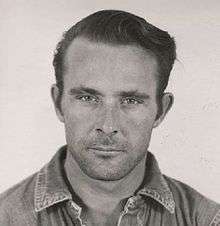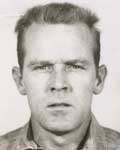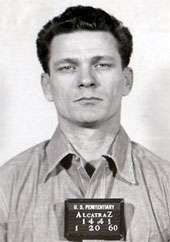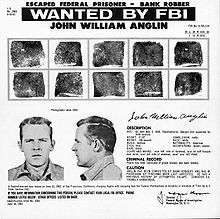June 1962 Alcatraz escape
Coordinates: 37°49′36″N 122°25′24″W / 37.82667°N 122.42333°W
.jpg) Alcatraz, with Angel Island (the fugitives' intended destination) in background | |
| Time | Approximately 10:00 PM (UTC-7)[1] |
|---|---|
| Date | June 11, 1962 |
| Location |
Alcatraz Island San Francisco, California, United States |
The June 1962 Alcatraz escape may have been the only successful escape from Alcatraz Federal Penitentiary in that facility's history. On the night of June 11 or early morning of June 12, inmates Clarence Anglin, John Anglin and Frank Morris tucked papier-mâché heads resembling their own likenesses into their beds, broke out of the main prison building via an unused utility corridor, and departed Alcatraz Island aboard an improvised inflatable raft to an uncertain fate.
Hundreds of leads have been pursued by the FBI and local law enforcement officials in the ensuing years, but no conclusive evidence has ever surfaced favoring the success or failure of the attempt. Numerous theories of widely varying plausibility have been proposed by authorities, reporters, family members, and amateur enthusiasts. In 1979 the FBI officially concluded, on the basis of circumstantial evidence and a preponderance of expert opinion, that the men drowned in the frigid waters of San Francisco Bay before reaching the mainland.[2] The U.S. Marshals Service case file remains open and active, however, and Morris and the Anglin brothers remain on its wanted list.
Recent experimental and computer-simulated evidence has suggested that the ultimate outcome of the attempt may have depended on the exact time of the men's departure aboard the raft. A 2015 documentary presented circumstantial evidence in support of a longstanding rumor that two of the men—the Anglin brothers—had survived and fled to Brazil; but a government expert concluded that the one piece of physical evidence, a 1975 photograph, did not support that conclusion.
Previous attempts
Of the 36 inmates who staged 14 escape attempts over the 29 years that Alcatraz served as a federal penitentiary,[3] 23 were recaptured, six were shot and killed, two drowned, and five (including Morris and the Anglins) are listed as missing and presumed drowned.
One inmate, John Paul Scott, successfully swam from the island to Fort Point, at the southern end of the Golden Gate Bridge, in December 1962. He was recaptured immediately, exhausted and hypothermic.[4] Today, multitudes of athletes swim the same Alcatraz-Fort Point route as part of one of two annual triathlon events.[5][6]
Inmates
Clarence and John Anglin


The Anglin brothers, Alfred Clarence (born May 11, 1931) and John William (born May 2, 1930), were born into a family of thirteen children in Donalsonville, Georgia. Their parents, George Robert Anglin and Rachael Van Miller Anglin, were seasonal farm workers; in the early 1940s, they moved the family to Ruskin, Florida, 20 miles south of Tampa, where the truck farms and tomato fields provided a more reliable source of income. Still, every June they would move north as far as Michigan to pick cherries. Clarence and John were reportedly inseparable as youngsters; they became skilled swimmers, and amazed their siblings by swimming in the frigid waters of Lake Michigan as ice still floated on its surface.[7]
They began robbing banks and other establishments as a team in the early 1950s, usually targets that were closed, to ensure that no one got injured. They claimed that they used a weapon only once, during a bank heist—a toy gun.[8] They were arrested in 1956. Both received 15- to 20-year sentences, which they served at Florida State Prison, Leavenworth Federal Penitentiary, and then Atlanta Penitentiary.
After repeated failed attempts to escape from the Atlanta facility, the brothers were transferred to Alcatraz.[9] John arrived on October 21, 1960, as inmate AZ1476, and Clarence on January 10, 1961, as inmate AZ1485.
Frank Morris

Frank Lee Morris was born in Washington, D.C. on September 1, 1926. He was orphaned at age 11 and spent most of his formative years in foster homes. He was convicted of his first crime at the age of 13, and by his late teens had been arrested for crimes ranging from narcotics possession to armed robbery.[10][11] Morris was exceptionally intelligent, ranking in the top 2% of the general population as measured by IQ testing. He served time in Florida and Georgia, then escaped from the Louisiana State Penitentiary while serving 10 years for bank robbery. He was recaptured a year later while committing a burglary, and sent to Alcatraz in 1960 as inmate number AZ1441.[12]
Allen West
Allen Clayton West was born on March 25, 1929.[13] Convicted of car theft in 1955, he was sent to Atlanta Penitentiary, and then to Florida State Prison. After an unsuccessful escape attempt in Florida he was transferred to Alcatraz in 1957 and became inmate AZ1335.
West was the only conspirator who did not participate in the actual escape, because he was unable to finish removing the ventilator grill in his cell in time. He cooperated fully with the escape investigation and was not charged for his role in the attempt.[14][15]
West was transferred to McNeil Island, Washington when Alcatraz was deactivated in 1963, and later, back to Atlanta Penitentiary. After serving his sentence, followed by two additional sentences in Georgia and Florida, he was released in 1967, only to be arrested again in Florida the following year on charges of grand larceny. At Florida State Prison he fatally stabbed another prisoner in October 1972, in what may have been a racially motivated incident. He was serving multiple sentences, including life imprisonment on the murder conviction, when he died of acute peritonitis on December 21, 1978, at the age of 49.[13]
Escape
The four inmates began formulating an escape strategy, under the leadership of Morris, the most intelligent of the four,[12] after they were assigned adjacent cells in December 1961.[3] (The men may have known one another previously at the federal penitentiary in Atlanta as well.[12]) Over the following six months they slowly widened ventilation duct openings in their cells' walls, using saw blades they had found discarded on the prison grounds, spoons stolen from the commissary, and a drill improvised from the motor of a broken vacuum cleaner. They concealed their work with cardboard and various other items.[3] The widened holes opened into an unguarded utility corridor behind the cell tier. From the corridor they climbed to the roof of their cell block, inside the building, where they set up a small workshop. There, they assembled a variety of stolen and donated materials, including more than 50 raincoats that they turned into makeshift life preservers and a 6-by-14-foot (1.8 by 4.3 m) rubber raft, the seams carefully stitched together and sealed with heat from nearby steam pipes. They built wooden paddles, and stole a small accordion-like concertina from another inmate to serve as a bellows to inflate the raft. Finally, they climbed a shaft of pipes and ducts to the building's roof, where they cut away most of the rivets holding a large ventilating fan and grille in place.[3][12]

To avoid discovery of their absence during bed checks while they were out of their cells—and after the escape itself—they sculpted dummy heads from a home-made papier-mâché-like mixture of soap and toilet paper, then gave them a realistic appearance using paint from the maintenance shop and hair from the barbershop floor. With towels and clothing piled under the blankets in their bunks, and the dummy heads positioned on the pillows, they appeared to be sleeping peacefully.[16]
On the night of June 11, 1962, with all preparations completed, the men initiated their escape.[3] West had used cement to shore up crumbling concrete around his vent opening, and it had hardened, narrowing the hole and fixing the grill in place. By the time he was able to remove the grill and re-widen the hole sufficiently, the others had left without him; he returned to his cell and went to sleep.[17] West later cooperated fully with investigators, giving them a detailed description of the escape plan, and as a result was not punished for his role in it.[12]
From the service corridor, Morris and the Anglins climbed the ventilation shaft to the roof. Guards heard a loud crash as they broke out of the shaft, but since nothing further was heard, the source of the noise was not investigated. Hauling their gear with them, they descended a 50-foot (15 m) wall by sliding down a kitchen vent pipe to the ground, then climbed two 12-foot (3.7 m) barbed-wire perimeter fences. At the northeast shoreline, near the power plant—a blind spot in the prison's network of searchlights and gun towers—they inflated their raft with the concertina. At some time after 10 o’clock, investigators estimated, they departed toward Angel Island, two miles to the north.[3][12]
Investigation

The escape was not discovered until the morning of June 12 due to the successful dummy head ruse.[18] An extensive air, sea, and land search involving multiple military and law enforcement agencies was conducted over the next 10 days. On June 14, a Coast Guard cutter picked up a paddle floating about 200 yards off the southern shore of Angel Island. On the same day in the same general location, workers on another boat found a wallet wrapped in plastic containing names, addresses and photos of the Anglins' friends and relatives. On June 21, shreds of raincoat material, believed to be remnants of the raft, were found on an Angel Island beach. The following day, a prison boat picked up a deflated life jacket made from the same material 50 yards off of Alcatraz Island. No human remains, nor any other physical evidence of the men's fate, were ever found.[7][12]
FBI investigators concluded that while it was theoretically possible for one or more of the inmates to have reached Angel Island, the frigid water temperature and strong currents within the bay made it unlikely.[3] According to West, the men had planned to steal clothes and a car once they reached land, but according to the final FBI report, no auto or clothing thefts were reported in that area following the escape, despite the high-profile nature of the case.[3][12] The FBI closed its file on December 31, 1979, after a 17-year investigation. Their official finding was that the prisoners most likely drowned in the cold waters of the bay while attempting to reach Angel Island.[3]
The U.S. Marshals Service investigation remains open, however. As Deputy U.S. Marshal Michael Dyke told NPR in 2009, "There's an active warrant, and the Marshals Service doesn't give up looking for people." He said that he still received leads on a regular basis.[19]
Aftermath
In 1993 a former Alcatraz inmate named Thomas Kent told the television program America's Most Wanted that he had helped plan the escape, and provided "significant new leads" to investigators.[20] He said that Clarence Anglin’s girlfriend had agreed to meet the men on the mainland and drive them to Mexico. He declined to participate in the actual attempt, he said, because he could not swim. Officials were skeptical of Kent's account, because he had been paid $2,000 for the interview.[12]
A 2003 MythBusters episode[21] on the Discovery Channel tested the feasibility of an escape from the island aboard a raft constructed with the same materials and tools available to the inmates, and determined that it was "plausible".[12] A 2011 program on the National Geographic Channel asserted that footprints were found on the Angel Island beach where the raft wreckage was recovered, and that contrary to the official FBI report, a car had been stolen nearby on the night of the escape.[12]
In 2011, an 89-year-old man named Bud Morris, who said he was a cousin of Frank Morris, claimed that on "eight or nine" occasions prior to the escape he delivered envelopes of money to Alcatraz guards, presumably as bribes. He further claimed to have met his cousin face to face in a San Diego park shortly after the escape. His daughter, who was "eight or nine" years old at the time, said she was present at the meeting with "Dad's friend, Frank", but "had no idea [about the escape]".[22]
In 2012, the 50th anniversary of the escape attempt, the Anglins' two sisters and two of their nephews made public their belief that Clarence and John—who would be well into their eighties—were still alive. Marie Anglin Winder claimed that in 1962, she received a phone call from San Francisco after the escape; the caller said, "This is John Anglin." The family also produced a Christmas card, purportedly received in the family mailbox in 1962, saying, "To Mother, from John. Merry Christmas."[23] Michael Dyke, the Deputy U.S. Marshal, conceded that there is a "possibility that they survived"—but noted that a Norwegian freighter reported seeing a body floating in the ocean 15 miles from the Golden Gate Bridge, about one month after the escape. "He had on prison clothes—a navy pea coat and a light pair of trousers—similar to what [Alcatraz] prisoners wore. There were no other missing people during that time period."[24]
In 2014 researchers at Delft University, using a computer model, concluded that if the men set off approximately at midnight, when the currents might have worked in their favor, they could have made landfall; but if they left during the hours before or after, the currents would have been too strong to overcome and they very likely died.[25]
A 2015 History Channel documentary presented further circumstantial evidence gathered over the years by the Anglin brothers' family. Christmas cards containing the Anglins' handwriting, and allegedly received by family members for three years after the escape, were displayed. While the handwriting was verified as the Anglins', none contained a postmarked stamp, so experts could not determine when they were delivered.[26] The family cited a story from family friend Fred Brizzi, who grew up with the brothers and claimed to have recognized them in Rio de Janeiro, Brazil in 1975. They produced photographs taken, they said, by Brizzi (who died in 1993), including one showing two men resembling John and Clarence Anglin and the farm near Rio where they were purportedly living.[27] Forensic experts hired by the History Channel confirmed that the photos were taken in 1975, and asserted that the two men were "more than likely" the Anglins.[28][29] Other evidence included the deathbed confession of another of the Anglins' 11 siblings, Robert, who told family members in 2010 that he had been in contact with John and Clarence from 1963 until approximately 1987.[30] The film also presented an alternate escape theory, involving the use of an electrical cord—which was reported missing from the prison's dock on the night of the escape—as a tow line, attached to a passenger ferry that departed the island shortly after midnight.[31]
Art Roderick, a retired Deputy U.S. Marshal working with the Anglin family, called Brizzi's photograph of the two men "absolutely the best actionable lead we've had"—but added, "it could still all be a nice story which isn't true"; or the photograph could be a misdirection, aimed at steering the investigation away from the Anglins' actual whereabouts.[30] Michael Dyke, the Deputy Marshal assigned to the case, said Brizzi was "a drug smuggler and a conman", and was suspicious of his account. An expert working for the U.S. Marshals Service reported that measurements of the photo subjects' physical features, compared to those of the Anglin brothers, indicated that they are not the men in the photo; although the age and condition of the photo, and the fact that both men were wearing sunglasses, hindered efforts to make a definitive determination.[32]
Surviving family members, who said they have heard nothing since Robert lost contact with the brothers in 1987, announced plans to travel to Brazil to conduct a personal search; but Roderick cautioned that they could be arrested by Brazilian authorities, because the Alcatraz escape remains an open Interpol case.[26] According to information obtained by a British newspaper, the FBI was aware of rumors that the Anglins were in Brazil as early as 1965. Agents dispatched to Rio at that time reportedly found no credible evidence that the fugitives were there.[30]
In popular culture
J. Campbell Bruce's 1963 book Escape from Alcatraz documents the 1962 escape, along with other escape attempts over the 29 years that Alcatraz Island served as a prison.[33]
The 1979 film Escape from Alcatraz stars Clint Eastwood, Fred Ward, and Jack Thibeau as Morris, John Anglin, and Clarence Anglin respectively. West (fictionalized as a character named Charley Butts) was played by Larry Hankin.[34] The film implied that the escape had been successful.[12]
See also
References
- ↑ FBI Investigation File 76-26295, pp. 32
- ↑ "Alcatraz Escape". FBI Records: The Vault. Retrieved 2 April 2013.
- 1 2 3 4 5 6 7 8 9 "A Byte out of History: Escape from Alcatraz". Federal Bureau of Investigation. June 8, 2007. Archived from the original on 2008-07-09. Retrieved 2008-11-30.
- ↑ "Alcatraz Escape Attempts". Alcatrazhistory.com. Retrieved 2011-01-24.
- ↑ Escape From Alcatraz Triathlon, retrieved November 9, 2015.
- ↑ San Francisco Triathlon at Alcatraz, retrieved November 9, 2015.
- 1 2 Kerr, J. (October 17, 1993). Flight from Alcatraz. SunSentinel.com, retrieved June 7, 2016.
- ↑ http://www.ruskinhistory.org/anglin-brothers.htm
- ↑ "Alcatraz Escape — June 11, 1962". Alcatraz History. 2008. Retrieved 2008-12-31.
- ↑ http://ghostsofdc.org/2012/09/10/frank-morris-alcatraz-escape/
- ↑ "The Great Escape From Alcatraz". Alcatrazhistory.com. Ocean View Publishing Company. p. 1. Retrieved July 23, 2014.
- 1 2 3 4 5 6 7 8 9 10 11 12 McFadden, Robert D. (June 9, 2012), "Tale of 3 Inmates Who Vanished From Alcatraz Maintains Intrigue 50 Years Later", The New York Times, New York, NY, retrieved June 9, 2012
- 1 2 Babyak, J (2001). Breaking the Rock: The Great Escape from Alcatraz. ISBN 0-9618752-3-2.
- ↑ "Alcatraz: Living Hell". video.nationalgeographic.co.in. National Geographic Channel. Retrieved 3 July 2012.
- ↑ http://The Great Escape from Alcatraz. [www.alcatrazhistory.com/alcesc2.htm AlcatrazHistory.com].
- ↑ "Valued exposure: Escape". BBC News. June 15, 2009. Retrieved May 7, 2010.
- ↑ Full text of Alcatraz Escape FBI Files. Archive.org, retrieved November 2, 2015.
- ↑ Marzilli, Alan (2003). Famous Crimes of the 20th Century. Philadelphia: Chelsea House. pp. 73–75. ISBN 9780791067888.
- ↑ "Escape From Alcatraz And A 47-Year Manhunt". National Public Radio. 2009. Retrieved 2009-09-21.
- ↑ Higbee, A. (November 13, 1993). American Topics : Alcatraz Escapees May Still Be Alive. New York Times archive, retrieved December 10, 2015.
- ↑ MythBusters, season 1, episode 11
- ↑ "Rome man claims he had role in escape from Alcatraz (2011)". WXIA-TV Atlanta. Retrieved 2011-12-31.
- ↑ Nolte, C. (March 18, 2013). Alcatraz escapees' family convinced brothers alive. sfgate.com.
- ↑ Leithead, A. (June 12, 2012). Alcatraz escape still surprises, 50 years on. BBC.com.
- ↑ Morelle, R. (December 15, 2014). Alcatraz 1962 escapees had small chance of success. BBC.com.
- 1 2 Notorious Alcatraz escapees may still be on the lam (October 19, 2015). CBC.ca, retrieved November 2, 2015.
- ↑ https://www.youtube.com/watch?v=S-RbxjEmLN4
- ↑ Graff, A. (October 12, 2015). "New claim: Alcatraz escapees might have survived. could still be alive". SF Gate. Retrieved October 13, 2015.
- ↑ "50 years later, new evidence suggests 3 Alcatraz escapees may still be alive". WPIX-11. October 12, 2015. Retrieved October 13, 2015.
- 1 2 3 Boyle, L. (October 15, 2015). Alcatraz escapees 'had wives and children in Brazil', their family claims - and they want their sentences commuted so they can 'come home' after 53 years. The Daily Mail, retrieved November 30, 2015.
- ↑ Staff Writer (October 12, 2015). "The picture that 'proves' two inmates DID escape from Alcatraz: Notorious escapees didn't drown, body-surfed behind a passenger ferry to freedom and started a farm in Brazil, claims family". Detroit Newstime. Retrieved October 13, 2015.
- ↑ Noyes, D. (May 15, 2016). New leads in manhunt for Alcatraz escapees. ABCnews.com, retrieved June 15, 2016.
- ↑ Bruce, Campbell J. (1963). Escape from Alcatraz. ISBN 1-58008-678-0.
- ↑ McGilligan, Patrick (1999). Clint: The Life and Legend. Harper Collins (2002), p. 307. ISBN 0-00-638354-8.
Bibliography
- "FBI Investigation File 76-26295{dead link}". Federal Bureau of Investigation. Retrieved 2008-12-07.
- Zimmerman, Keith; Zimmerman, Kent; Hyneman, Jamie; Savage, Adam; Rees, Peter (2005). Mythbusters: The Explosive Truth Behind 30 of the Most Perplexing Urban Legends of All Time. Simon & Schuster. ISBN 978-1-4169-0929-3.
- 'Escape from Alcatraz' in Fascinating Footnotes from History. by Giles Milton (published as When Hitler Took Cocaine and Lenin Lost His Brain. in US)
